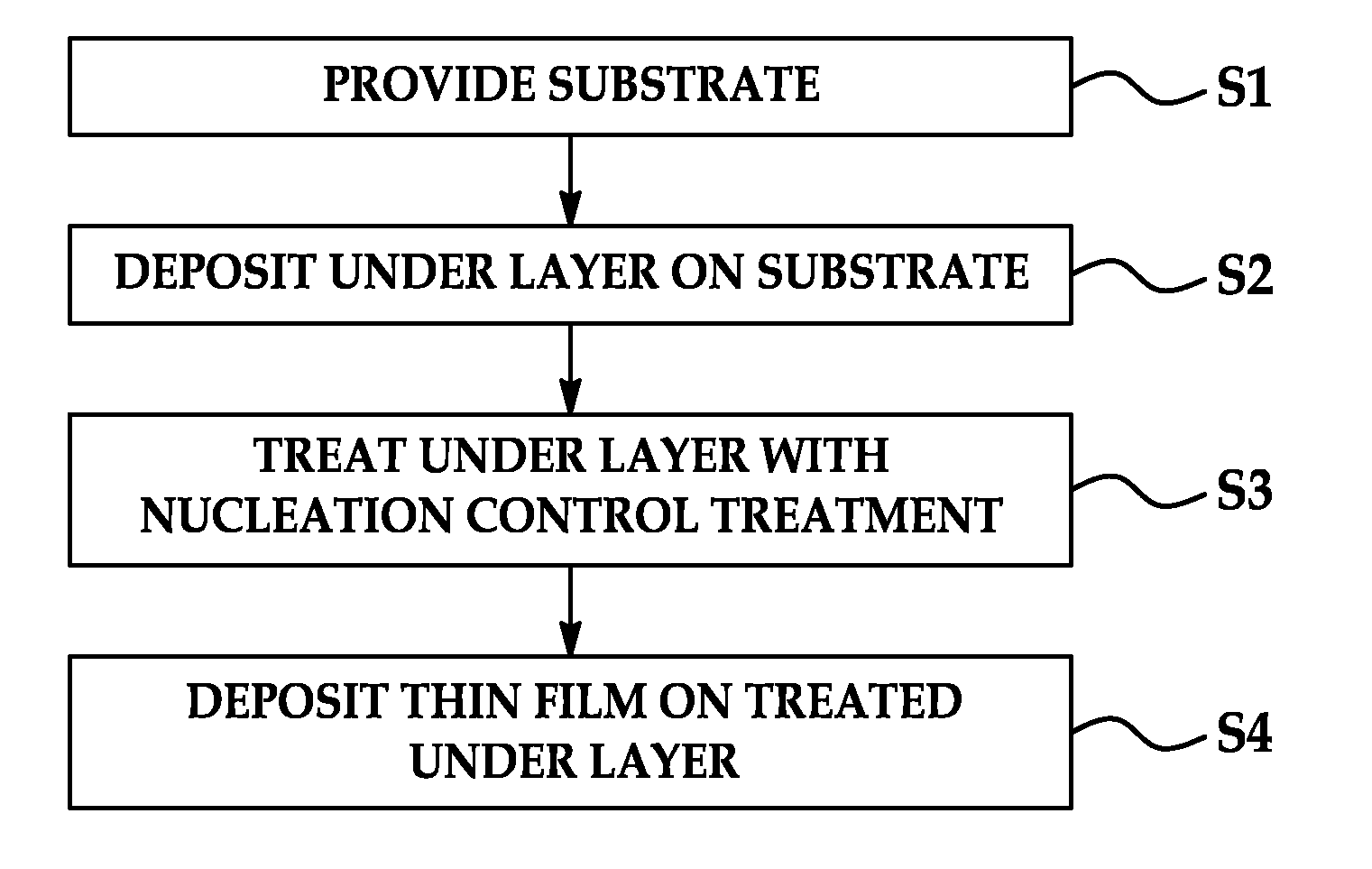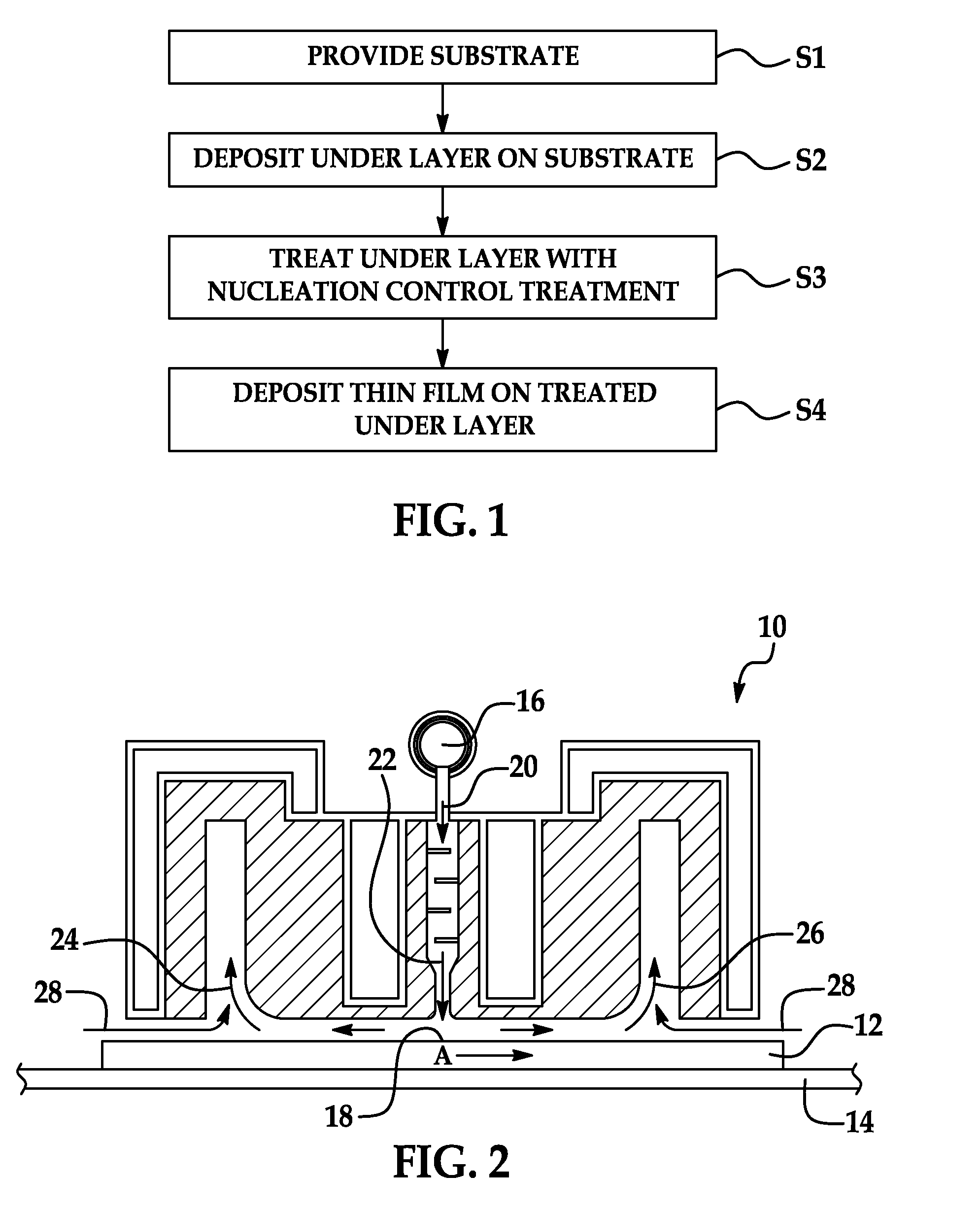Methods of nucleation control in film deposition
- Summary
- Abstract
- Description
- Claims
- Application Information
AI Technical Summary
Benefits of technology
Problems solved by technology
Method used
Image
Examples
experiment example 1
[0042]This example deposits an FTO film directly on a glass substrate. As mentioned above and noted in the results, uncoated glass is a relatively good nucleator for TCO but has long term negative effects on the top coat film.
[0043]A thin film top coat of FTO approximately 300 nm thick was deposited directly on a glass substrate with 40 Kg / hr MBTC; H2O at a molar ratio H2O / MBTC of 1.5; TFAA at a molar ratio MBTC / TFAA of 0.3; and nitrogen as a carrier gas at standard conditions of temperature and pressure (STP) at 70 m3 / hr.
[0044]The resulting thin film surface resistivity (SR) was 18 ohms per square and the resulting haze was 1.5%. Ohms per square is the unit of an electrical measurement of surface resistivity across any given square area of a material.
experiment example 2
[0045]An FTO layer as the thin film is deposited onto an untreated under layer of SiCO results in high haze and low conductivity. A SiCO under layer was deposited on a glass substrate with 0.9 Kg / hr silane, 3.6 Kg / hr ethylene, 3.6 Kg / hr CO2, and nitrogen as a carrier gas at STP at 4.5 m3 / hr.
[0046]A thin film top coat of FTO was deposited on the under layer with 40 Kg / hr MBTC; H2O at a molar ratio H2O / MBTC of 1.5; TFAA at a molar ratio MBTC / TFAA of 0.3; and nitrogen as a carrier gas at STP at 70 m3 / hr.
[0047]Results were variable with the thin film SR varying across the substrate from run to run between approximately 40 ohms per square and 150 ohms per square. Haze was also variable from between about 3% and 7%.
experiment example 3
[0048]A thin film layer of FTO is deposited on an under layer of silica film with carbon incorporated (SiCO) where the SiCO layer is treated with dry air prior to deposition of the FTO thin film layer. The air flow rate is not critical to make a major change in properties of the top coat. In this example, it was set at approximately 3.0 m3 / hr.
[0049]The SiCO under layer was deposited on a glass substrate with 0.9 Kg / hr silane, 3.0 Kg / hr ethylene, 3.0 Kg / hr CO2, and nitrogen as a carrier gas at STP at 8.0 m3 / hr.
[0050]The thin film top coat of FTO approximately 290 nm thick was deposited with 40 Kg / h MBTC; H2O at a molar ratio H2O / MBTC of 3.0; TFAA at a molar ratio MBTC / TFAA of 0.3; and nitrogen as a carrier gas at STP at 70 m3 / hr. The resulting SR was between about 25 to 31 ohms per square with a haze of 1.5%.
PUM
| Property | Measurement | Unit |
|---|---|---|
| Sheet resistance | aaaaa | aaaaa |
| Sheet resistance | aaaaa | aaaaa |
| Electrical conductivity | aaaaa | aaaaa |
Abstract
Description
Claims
Application Information
 Login to View More
Login to View More - R&D
- Intellectual Property
- Life Sciences
- Materials
- Tech Scout
- Unparalleled Data Quality
- Higher Quality Content
- 60% Fewer Hallucinations
Browse by: Latest US Patents, China's latest patents, Technical Efficacy Thesaurus, Application Domain, Technology Topic, Popular Technical Reports.
© 2025 PatSnap. All rights reserved.Legal|Privacy policy|Modern Slavery Act Transparency Statement|Sitemap|About US| Contact US: help@patsnap.com


